The Lord of the Rings: Return to Moria review - diamonds amongst the rough
Home's where the hearth is.
I, for one, am thrilled that we are currently seeing a spate of weird and wonderful games set in Middle-earth. Although these games take creative risks that don't always work out, it's fascinating to see how developers can interpret Tolkien's legendarium in ways that are a little bit unexpected. And it's particularly exciting when a game focuses on a specific location or people in Middle-earth to really explore them in detail. (Pencil that cosy Hobbit game releasing next year into your diaries.)
Which brings us to The Lord of the Rings: Return to Moria - a game that, as Gimli describes it in the introduction, allows the dwarves to tell their own story from their perspective. Set after the fall of Sauron and the destruction of the One Ring, Gimli has called for dwarves across Middle-earth to help him reclaim the underground kingdom of Khazad-dûm from darkness and shadow. You play as one of the members of this expedition, ready to help Gimli swap out hordes of orcs for hoards of treasure. But before you can enter Moria in an organised and orderly fashion, a mysterious explosion separates you from the rest of the group. You (and any co-op friends) wake up alone in the dark - unable to get out, and with no sign of Gimli. You venture forth to find the rest of the expedition, uncovering the secrets of Moria along the way. And so the stage is set for a game that blends survival-crafting mechanics with the lore and mystique of Tolkien's Middle-earth.
It's a combination that works so well, you wonder why nobody thought of it before. The dwarves are renowned for their mining and metalworking skills, making them great protagonists for a survival-crafting game. The setting of Moria ensures there is plenty of treasure and ore to be found... along with plenty of monsters. It's a great premise in itself, but the way this location has been realised in-game is truly impressive. The environments of Khazad-dûm are beautiful and haunting, and journeying through the depths proves to be an unbelievably atmospheric experience. Yet this is a game with problems. Like an uncut gem, it's pretty rough around the edges, and depending on your level of tolerance for jank you may find this to be an endearing experience - or one that's simply frustrating.
When you are first plonked down inside Moria (having selected a particularly glorious beard for your dwarf), your first priority is gathering basic resources, building a camp, and slowly exploring the caverns. In comparison to other survival games such as Valheim, Return to Moria feels unusually focused: there is a clear narrative line through the world, with specific story events, quest objectives and defined regions that are accessed in a relatively linear fashion. Within each of these regions, however, there is plenty of freedom to explore. There are large preset areas that appear in each playthrough, and splintering off from these are a maze of procedurally-generated rooms filled with resources and enemies, making each journey feel unique. You never truly know what you'll find when tunnelling between rooms: it might be an iron ore vein, it might be a cave troll. Who knows!
Exploration is a particularly spooky experience in single-player, where it truly feels like you are alone against all the forces of the mountain. Return to Moria is filled with some of the most disturbing ambient noises I have ever heard in a game. Without a constant musical soundtrack, you are left listening to the terrible sounds produced by creatures in the deep. Strange rushes of wind, weird trumpet-like noises, the distant ring of a gong - it's enough to leave you permanently on edge. Even when playing with a friend, we frequently found ourselves pausing our activities to nervously ask each other "...what was that?"
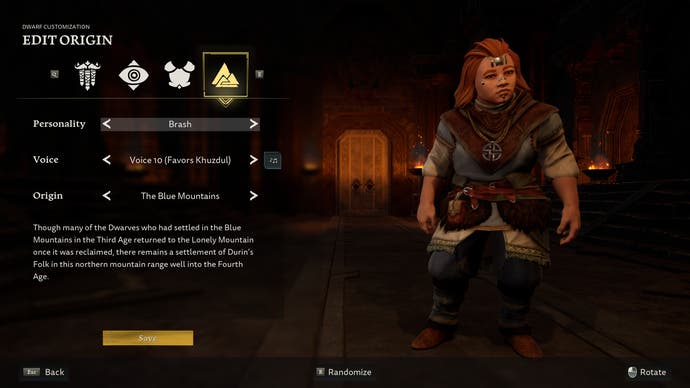

Return to Moria establishes a powerfully foreboding mood, and for Lord of the Rings enthusiasts, it's worth playing just for this sense of immersion. The environments are gorgeous and surprisingly varied considering the entire game takes place underground. The layered levels and vast premade areas (particularly the Mines of Moria) conjure up a grand sense of scale and verticality - enough to make you believe that you are, indeed, down in the very depths of a mountain. Some of the locations were so unexpected that I couldn't help but gasp when entering a new area. With plenty of lore items to discover, it's exciting to feel like you're stepping through places where Balin's folk or the Fellowship previously ventured. I found myself gleefully fangirling over hobbit crockery, and reverently observing some of the more sombre locations.
There's more to this game than just reading lore entries, however: Return to Moria evokes the very feeling of a Tolkien journey. In a strange twist of fate I happened to be re-reading The Fellowship of the Ring at the same time as playing this, and it's easy to trace stylistic parallels between the book and this game. Much like Frodo's adventure - which in its early stages alternates between dangerous encounters and resting at homely houses - there are moments of respite in Return to Moria. The journey isn't a straight line to a darker, more dangerous place: there are lighter environments that inspire hope and a slight lifting of tension. You explore one place down in the oppressive depths, then are lifted back up again to somewhere brighter. Respite comes, too, in the form of setting up camp and building cosy hideaways in the darkness. It's even possible to quickly renovate abandoned outposts with a reduced resource cost, which feels like receiving much-needed aid from your dwarven ancestors. The act of leaving these places of safety to move into the unknown, meanwhile, becomes ominous and scary. It made me sympathise with Frodo's reluctance to leave places like The Shire, Tom Bombadill's House and Rivendell to move towards greater danger.
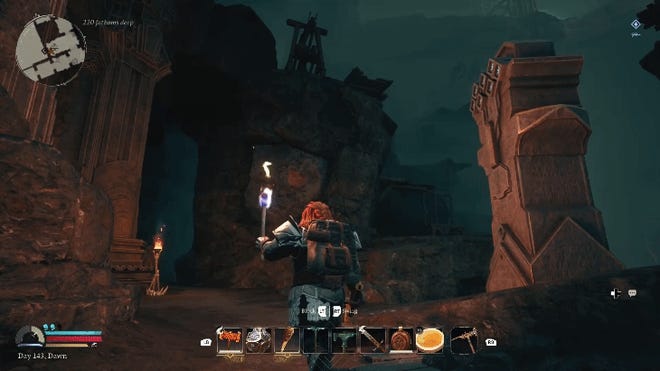
The concept of resting at camp is actually pretty central to Return to Moria: where other survival games allow you to take food on the road, here your on-the-road rations can only top you up and won't give you a full 'well-fed' buff. Similarly, you can't simply run around like a wraith without ever sleeping, as this will earn you some serious debuffs. For most of the game you will need to cook something on a fire and settle down for a proper kip. It makes the expedition feel more grounded, and forces you to plan what you will achieve in a day. (Yes, surprisingly there is a day-night cycle, with more monsters skulking about at night and the threat of 'despair' damage if you stand in the dark for too long.) For this reason, food planning becomes vitally important. And the recipes are delightful in themselves - unlocking them feels as great an achievement as crafting a new weapon. I found myself marvelling at dishes like the shire breakfast, looking closely at the in-game model to figure out its components.
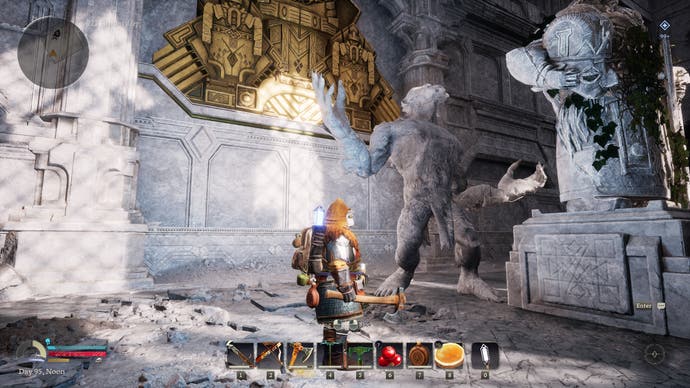
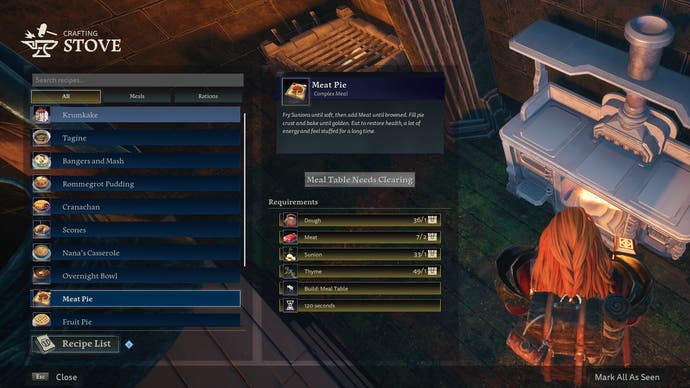
Moments of lightness are also found through singing - another staple of Tolkien's books, of course. When mining, drinking or repairing certain statues, your dwarf can burst into song, providing a flavour of dwarven storytelling and culture. (It's also a clever form of distraction when mining ore veins.) The songs are even better if you have a co-op friend with you, as the dwarves will harmonise together, and dance around with tankards on their heads when having a brew. Return to Moria is at its spookiest when played solo, but when played with friends online, it's a whole lot sillier. The process of discovery just becomes better when you have someone else to experience it with. One of my strongest memories involves my friend and I throwing junk items down into what we thought was an endless pit... until we saw our trash hit the floor. Aha! Naturally, we climbed down to investigate. We then had what can only be called an 'unpleasant encounter' with a lumbering fiery beast. Terrified and screaming, we dashed back up the ladders again. Only one of us made it.
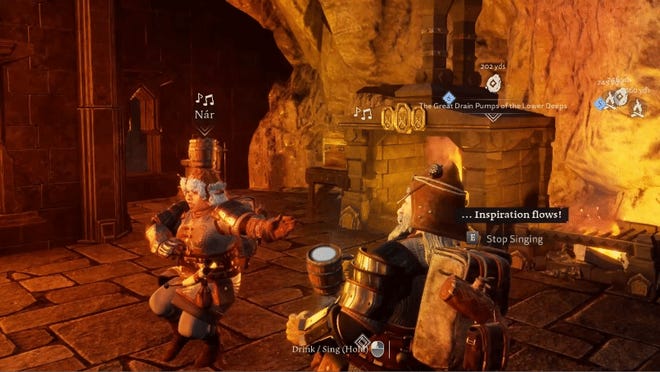
There's so much to be positive about here - and I adore the mood of Return to Moria - but there are some noticeable flaws in this gem. The survival-crafting loop is perfectly serviceable, following standard resource-gathering/tool-upgrading patterns used by other games, but it doesn't bring anything particularly new to the table. Combat is fairly basic, allowing you to block, parry or dodge-roll past enemies, but it's mainly about managing large numbers of orcs and isn't particularly inspiring. The building system also leaves a fair bit to be desired. It can be difficult to align pieces accurately, while the support system is inconsistent and frequently results in older buildings exploding as you try to renovate them. A greater variety of build pieces would have been nice to see - things like roofs, more decorative items, and tower defence traps to offset the large number of orcs that turn up in raids.
Balancing issues also become a problem at certain points of the game, particularly when playing solo. In several regions progression is gated by a demand to find black diamonds, but in some areas it can be tough to discover enough orc camps from which to collect these. In one region progression relies on storming an orc town to collect these diamonds: a tough ask for solo players due to the seemingly-endless supply of orcs that pop up there. The frequency of orc raids on your camps, meanwhile, can sometimes be excessive and needs a longer cooldown. At the mid-way point in the game, you might also find yourself running low on finite supplies like elven wood. Though one solution is to load up a new world and harvest materials there, this can somewhat ruin your sense of immersion.

Then, of course, there are the bugs (and I don't mean the giant moth infestation in the Lower Deeps). There are audio dropouts, items that fall through the world, quest markers that linger once the objective has been completed, glitches that make all the enemies vanish... the list goes on. Last week my friend and I also experienced some lengthy loading times in online mode, a problem that has thankfully improved over the last few days. It's still entirely possible to get through Return to Moria, but these annoyances do detract from the experience. This is a game that requires more polish - not only to squash the bugs, but to improve the quality of existing features. The need for further refinement is noticeable even in the smaller details, such as orcs yelling out the same few voice lines for several hours. I have never heard the word "brutalise" so many times in a week.
In positive news, the dev team has already announced a major patch for this week targeting over 100 bugs, so that should hopefully iron out some of the issues. The same post reveals further usability improvements to come for things like inventory management and gathering items. In its current state, however, this is a game with a lot of soul and a lot of problems, even if I've still found myself willingly sinking dozens of hours into exploring the mines - the survival-crafting formula may not be new, but it's still engaging. What is unique about Return to Moria is the way it pairs a relatively focused story with survival mechanics, keeping you (quite literally) in the dark on what could be around the next corner. The manner in which the game has been infused with Tolkien's lore and worldbuilding is impressive, and that it somehow evokes the feeling of a Tolkien journey is remarkable in itself. For fans of Middle-earth this is worth experiencing, particularly if someone else joins you for the adventure. So if you're willing to forgive the jank: add friend, and enter.
A copy of The Lord of the Rings: Return to Moria was provided for review by North Beach Games.









